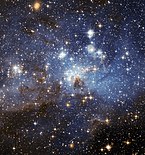

| Star formation |
|---|
 |
| Object classes |
| Theoretical concepts |
|
|
Young stellar object (YSO) denotes a star in its early stage of evolution. This class consists of two groups of objects: protostars and pre-main-sequence stars.
A star forms by accumulation of material that falls in to a protostar from a circumstellar disk or envelope. Material in the disk is cooler than the surface of the protostar, so it radiates at longer wavelengths of light producing excess infrared emission. As material in the disk is depleted, the infrared excess decreases. Thus, YSOs are usually classified into evolutionary stages based on the slope of their spectral energy distribution in the mid-infrared, using a scheme introduced by Lada (1987). He proposed three classes (I, II and III), based on the values of intervals of spectral index 

Here 

The 







This classification schema roughly reflects evolutionary sequence. It is believed that most deeply embedded Class 0 sources evolve towards Class I stage, dissipating their circumstellar envelopes. Eventually they become optically visible on the stellar birthline as pre-main-sequence stars.
Class II objects have circumstellar disks and correspond roughly to classical T Tauri stars, while Class III stars have lost their disks and correspond approximately to weak-line T Tauri stars. An intermediate stage where disks can only be detected at longer wavelengths (e.g., at 
YSOs are also associated with early star evolution phenomena: jets and bipolar outflows, masers, Herbig–Haro objects, and protoplanetary disks (circumstellar disks or proplyds).

These stars may be differentiated by mass: Massive YSOs, intermediate-mass YSOs, and brown dwarfs.
 Ophiuchi A: The Candidate Protostar VLA 1623 and Prestellar Clumps". The Astrophysical Journal, Part 1. 406 (1): 122–141. Bibcode:1993ApJ...406..122A. doi:10.1086/172425.
Ophiuchi A: The Candidate Protostar VLA 1623 and Prestellar Clumps". The Astrophysical Journal, Part 1. 406 (1): 122–141. Bibcode:1993ApJ...406..122A. doi:10.1086/172425.
 Ophiuchi Cloud Young Stellar Population: Luminosities and Masses of Pre-main-sequence Stars". The Astrophysical Journal, Part 1. 434 (2): 614–626. Bibcode:1994ApJ...434..614G. doi:10.1086/174763.
Ophiuchi Cloud Young Stellar Population: Luminosities and Masses of Pre-main-sequence Stars". The Astrophysical Journal, Part 1. 434 (2): 614–626. Bibcode:1994ApJ...434..614G. doi:10.1086/174763.
![]() Media related to Young stellar objects at Wikimedia Commons
Media related to Young stellar objects at Wikimedia Commons
|
| |||||||
|---|---|---|---|---|---|---|---|
| |||||||
| Formation |
| ||||||
| Evolution |
| ||||||
| Classification |
| ||||||
| Nucleosynthesis |
| ||||||
| Structure |
| ||||||
| Properties |
| ||||||
| Star systems |
| ||||||
| Earth-centric observations |
| ||||||
| Lists |
| ||||||
| Related |
| ||||||
| |||||||